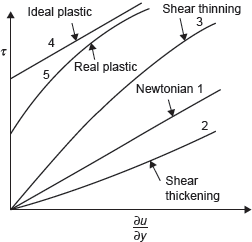An ideal fluid has zero viscosity. Shear force is not involved in its deformation. An ideal fluid must be incompressible. Shear stress is zero irrespective of the value of ∂u/∂y. Bernoulli equation can be used to analyse the flow. Real fluids having viscosity are divided into two categories, namely, Newtonian and non-Newtonian fluids. In Newtonian fluids a linear relationship exists between the magnitude of the applied shear stress and the resulting rate of deformation. It means that the proportionality parameter, μ is constant in the case of Newtonian fluids. The viscosity at any given temperature and pressure is constant for a Newtonian fluid and is independent of the rate of deformation. The characteristics are plotted in Figure 9.2.

Figure 9.2 Type of Fluids
Non-Newtonian fluids can be further classified as simple non-Newtonian, ideal plastic, and shear thinning, shear thickening, and real plastic fluids. In non-Newtonian fluids, viscosity varies with variation in the rate of deformation. Linear relationship between shear stress and rate of deformation (∂u/∂y) does not exist. In plastics, up to a certain value of applied shear stress there is no flow. After this limit, it has a constant viscosity at any given temperature. In shear thickening materials, the viscosity increases with (∂u/∂y) deformation rate. In shear thinning, materials viscosity decreases with (∂u/∂y).
Leave a Reply